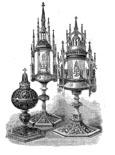
The Lure of Catholicism
MERTON'S GENERATION & OUR OWN
Ed. Note: The following is based on the author’s Thomas Merton Lecture at Columbia University, delivered on November 16, 1994, the 56th anniversary of Thomas Merton’s reception into the Catholic Church.
Thomas Merton’s journey to the Catholic faith was fairly typical for college-educated intellectuals of his day, at least in England and the U.S. After his birth in France he was raised in Douglaston, Long Island, where he occasionally attended a small Protestant church at which his father, an artist, sometimes played the organ. Still without any clear Christian convictions, young Thomas went with his father to France, where he spent two years, but was not exposed to Catholic influences. Then he went to high school in England and spent a freshman year at Cambridge University. In England he lived a rather dissolute life, without much interest in religion. An exception occurred during a brief trip to Rome in the spring of 1933, when he visited many churches and found himself moved to pray (almost for the first time in his life) before the magnificent mosaics of Christ. During his year at Cambridge he experienced only one positive grace. He read Dante, from whose Divine Comedy he was later to take the title of his Seven Storey Mountain (Dante’s Purgatory has seven terraces, corresponding to the seven capital sins that Merton had to overcome in himself).
Merton entered Columbia in 1935, at the age of 20. In a course on French literature he came across the work of Catholic philosopher Etienne Gilson, an outstanding medievalist. Gilson familiarized him with the Scholastic concept of God as the self-existent being from whom all other existence derives. That concept, Merton says, revolutionized his whole life. By the time he received his Bachelor of Arts degree in 1938 he was well on his way to the Church. As a graduate student in English, he then wrote an M.A. thesis, applying to William Blake the aesthetic theories of another French philosopher, Jacques Maritain, himself a convert to Catholicism. Living authors such as Gilson and Maritain aroused Merton’s interest in contemporary Catholicism. He attended Mass for the first time at Corpus Christi Church, and soon afterward asked the pastor of that Church, Father Ford, for instruction in the Catholic faith. When he was received into the Church, on November 16, 1938, he was 22 years old.
Merton is only one of dozens of young intellectual converts of the late 1930s. His story closely parallels my own experience at Harvard, and that of several of my acquaintances there. As a boy I had gone to school in Switzerland, and had been impressed by the religious art and architecture of France and Italy. About the same time as Merton, I discovered Gilson and Maritain, and eagerly devoured their works. Reading the novels of James Joyce and the poems of Gerard Manley Hopkins, I felt the same fascination that Merton did with the Catholic culture reflected in these works. But unlike Merton, who seems to have detested Plato, I developed a great affection for Plato and for the Platonism of the Italian Renaissance. I received my A.B. in 1940, two years after Merton, and became a Catholic later in the same year, shortly after entering Harvard Law School.
You May Also Enjoy
Many presume that Orthodoxy is merely Catholicism without a pope. This is not so.
Some Catholics say we should leave "anonymous Christians" alone, that they have at least a partial grasp of the truth and that will be enough to bring them to salvation.
Fourteen American women tell how they found their way to the Church via a need for Church authority and the discovery that holiness is a journey.

